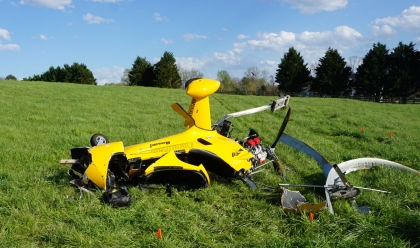Fuel that was contaminated with water and the pilot’s “inadequate” preflight inspection ultimately led to the crash of a small experimental plane crash nearly two years ago that killed the pilot, 75-year-old Larry Priess of Gainesville.
“The National Transportation Safety Board (NTSB) determines the probable cause(s) of this accident to be:
The pilot’s inadequate preflight inspection and his failure to detect water-contaminated fuel
that resulted in a loss of engine power and subsequent impact with a wire and terrain during
an attempted forced landing,” the agency’s final report on the crash which was issued this week concludes.
Preiss died of “blunt force injuries,” according to an autopsy report cited in the NTSB findings.
“A review of the onboard video recording revealed that, before the descent, the engine was
heard surging,” the report says. “Moments later, audio from the camera was characterized as being primarily wind and rotor noise. As the gyrocopter descended, the engine’s power seemed to decrease.
The gyrocopter was seen approaching an open field, and the descent appeared controlled.
However, as it got closer to the ground, the landing area appeared to be upsloping. A utility
pole was visible in the vicinity of the field. Moments later, the gyrocopter struck a powerline,
rapidly pitched downward and then impacted the ground.”
(NTSB photo)


